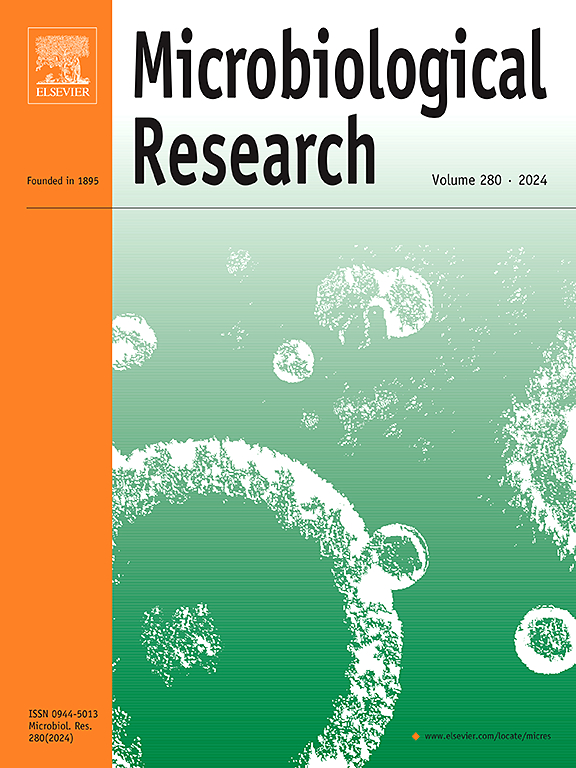Genomic and phenotypic analysis of probiotic properties of GABA-producing Enterococcus lactis A1 in Micropterus salmoides aquaculture
IF 6.9
1区 生物学
Q1 MICROBIOLOGY
引用次数: 0
Abstract
Aquaculture contributes substantially to global food and nutrition security. Dysfunction of the fish intestinal mucosal barrier increases susceptibility to pathogens and affects aquaculture production. Indigenous probiotics, specifically those targeting intestinal health, are promising agents for disease control and growth promotion. Gamma-aminobutyric acid (GABA), derived from microorganisms, is a postbiotic with multiple beneficial functions. However, there is a lack of reports on GABA-producing probiotic strains in aquatic animals. Herein, we evaluated the probiotic properties of Enterococcus lactis A1 isolated from the gut of Micropterus salmoides. Whole-genome sequencing revealed its potential to synthesize GABA, which was confirmed in MRS broth and commercial feed. The strain contained multiple bacteriocin genes and showed antibacterial activity against bacterial pathogens prevalent in aquaculture. Genomic and phenotypic analyses revealed its biosafety, stress tolerance, and adhesion ability. In vitro, it exhibited immunomodulatory properties and displayed resistance against Aeromonas hydrophila in M. salmoides head kidney lymphocytes. An eight-week in vivo study showed that orally supplemented E. lactis A1 significantly promoted growth, enhanced intestinal trypsin and lipase activities, increased the activities of superoxide dismutase and catalase, and reduced the malondialdehyde levels. Diversity and composition of the intestinal microbiota were positively modulated by E. lactis A1. Moreover, it effectively improved intestinal morphology by increasing villus height and improving resistance against A. hydrophila infection, as indicated by improved intestinal integrity, reduced blood pathogen counts, and increased fish survival rates. This study highlights the potential of GABA-producing E. lactis A1 as a probiotic for growth promotion and disease resistance in M. salmoides.
产氨基丁酸乳肠球菌A1在小鱼养殖中益生菌特性的基因组和表型分析
水产养殖对全球粮食和营养安全作出了重大贡献。鱼类肠黏膜屏障功能障碍会增加对病原体的易感性,影响水产养殖生产。原生益生菌,特别是针对肠道健康的益生菌,是控制疾病和促进生长的有前途的药物。γ -氨基丁酸(GABA)来源于微生物,是一种具有多种有益功能的后生物。然而,在水生动物中产生gaba的益生菌菌株缺乏报道。在此,我们评估了从小翼鱼(Micropterus salmoides)肠道分离的乳酸肠球菌A1的益生菌特性。全基因组测序显示其具有合成GABA的潜力,并在MRS肉汤和商业饲料中得到证实。该菌株含有多种细菌素基因,对水产养殖中常见的病原菌具有一定的抑菌活性。基因组和表型分析显示其生物安全性,耐受性和粘附能力。在体外实验中,它具有免疫调节作用,并对沙棘头肾淋巴细胞中嗜水气单胞菌具有抗性。为期8周的体内研究表明,口服乳杆菌A1可显著促进生长,提高肠道胰蛋白酶和脂肪酶活性,提高超氧化物歧化酶和过氧化氢酶活性,降低丙二醛水平。乳酸菌A1对肠道菌群的多样性和组成有正向调节作用。此外,它通过增加绒毛高度和提高对嗜水单胞菌感染的抵抗力,有效改善肠道形态,改善肠道完整性,降低血液病原体计数,提高鱼的存活率。本研究强调了产生gaba的乳杆菌A1作为促进salmoides生长和抗病的益生菌的潜力。
本文章由计算机程序翻译,如有差异,请以英文原文为准。
求助全文
约1分钟内获得全文
求助全文
来源期刊

Microbiological research
生物-微生物学
CiteScore
10.90
自引率
6.00%
发文量
249
审稿时长
29 days
期刊介绍:
Microbiological Research is devoted to publishing reports on prokaryotic and eukaryotic microorganisms such as yeasts, fungi, bacteria, archaea, and protozoa. Research on interactions between pathogenic microorganisms and their environment or hosts are also covered.
 求助内容:
求助内容: 应助结果提醒方式:
应助结果提醒方式:


